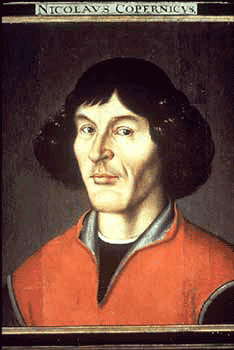| Nicolaus Copernicus  Born: 19-Feb-1473 Born: 19-Feb-1473
Birthplace: Torun, Poland
Died: 24-May-1543
Location of death: Frauenburg, East Prussia
Cause of death: Stroke
Remains: Buried, St. John's Cathedral, Frombork, Poland
Gender: Male
Religion: Roman Catholic
Race or Ethnicity: White
Sexual orientation: Straight
Occupation: Astronomer, Mathematician Nationality: Poland
Executive summary: Heliocentrist, De revolutionibus Polish astronomer, born on the 19th of February 1473, at Thorn in Prussian Poland, where his father, a native of Krakow, had settled as a wholesale trader. His mother, Barbara Watzelrode, belonged to a family of high mercantile and civic standing. After the death of his father in 1483, Nicolaus was virtually adopted by his uncle Lucas Watzelrode, later (in 1489) bishop of Ermeland. Placed at the university of Krakow in 1491, he devoted himself, during three years, to mathematical science under Albert Brudzewski (1445-1497), and incidentally acquired some skill in painting. At the age of twenty-three he repaired to Bologna, and there varied his studies of canon law by attending the astronomical lectures of Domenico Maria Novara (1454-1504). At Rome, in the Jubilee year 1500, he himself lectured with applause; but having been nominated in 1497 canon of the cathedral of Frauenburg, he recrossed the Alps in 1501 with the purpose of obtaining further leave of absence for the completion of his academic career. Late in the same year, accordingly, he entered the medical school of Padua, where he remained until 1505, having taken meanwhile a doctor's degree in canon law at Ferrara on the 31st of May 1503. After his return to his native country he resided at the episcopal palace of Heilsberg as his uncle's physician until the latter's death on the 29th of March 1512. He then retired to Frauenburg, and vigorously attended to his capitular duties. He never took orders, but acted continually as the representative of the chapter under harassing conditions, administrative and political; he was besides commissary of the diocese of Ermeland; his medical skill, always at the service of the poor, was frequently in demand by the rich; and he laid a scheme for the reform of the currency before the Diet of Graudenz in 1522. Yet he found time, amid these multifarious occupations, to elaborate an entirely new system of astronomy, by the adoption of which man's outlook on the universe was fundamentally changed.
The main lines of his great work were laid down at Heilsberg; at Frauenburg, from 1513, he sought, with scanty instrumental means, to test by observation the truth of the views it embodied. His dissatisfaction with Ptolemaic doctrines was of early date; and he returned from Italy, where so-called Pythagorean opinions were then freely discussed, in strong and irrevocable possession of the heliocentric theory. The epoch-making treatise in which it was set forth, virtually finished in 1530, began to be known through the circulation in manuscript of a Commentariolus, or brief popular account of its purport written by Copernicus in that year. Johann Albrecht Widmanstadt lectured upon it in Rome; Pope Clement VII approved, and Cardinal Schönberg transmitted to the author a formal demand for full publication. But his assent to this was only extracted from him in 1540 by the importunities of his friends, especially of his enthusiastic disciple George Joachim Rheticus (1514-1576), who printed, in the Narratio prima (Danzig, 1540), a preliminary account of the Copernican theory, and simultaneously sent to the press at Nuremberg his master's complete exposition of it in the treatise entitled De revolutionibus orbium coelestium (1543). But the first printed copy reached Frauenburg barely in time to be laid on the writer's deathbed. Copernicus was seized with apoplexy and paralysis towards the close of 1542, and died on the 24th of May 1543, happily unconscious that the fine Epistle, in which he had dedicated his life's work to Pope Paul III, was marred of its effect by an anonymous preface, slipped in by Andreas Osiander, with a view to disarming prejudice by insisting upon the purely hypothetical character of the reasonings it introduced. The trigonometrical section of the book had been issued as a separate treatise (Wittenberg, 1542) under the care of Rheticus. The only work published by Copernicus on his own initiative was a Latin version of the Greek Epistles of Theophylact (Krakow, 1509). His treatise De monetae cudendae ratione, 1526 (first printed in 1816), written by order of King Sigismund I, is an exposition of the principles on which it was proposed to reform the currency of the Prussian provinces of Poland. It advocates unity of the monetary system throughout the entire state, with strict integrity in the quality of the coin, and the charge of a seigniorage sufficient to cover the expenses of mintage.
Father: Niklas Koppernigk (d. 1483-5)
Mother: Barbara Watzelrode
Brother: Andreas
Sister: Barbara
Sister: Katharina
University: Jagiellonian University, Krakow
University: University of Bologna
University: University of Padua
Stroke 1542
Coma
Exhumed Aug-2005
Lunar Crater Copernicus
Do you know something we don't?
Submit a correction or make a comment about this profile
Copyright ©2019 Soylent Communications
|